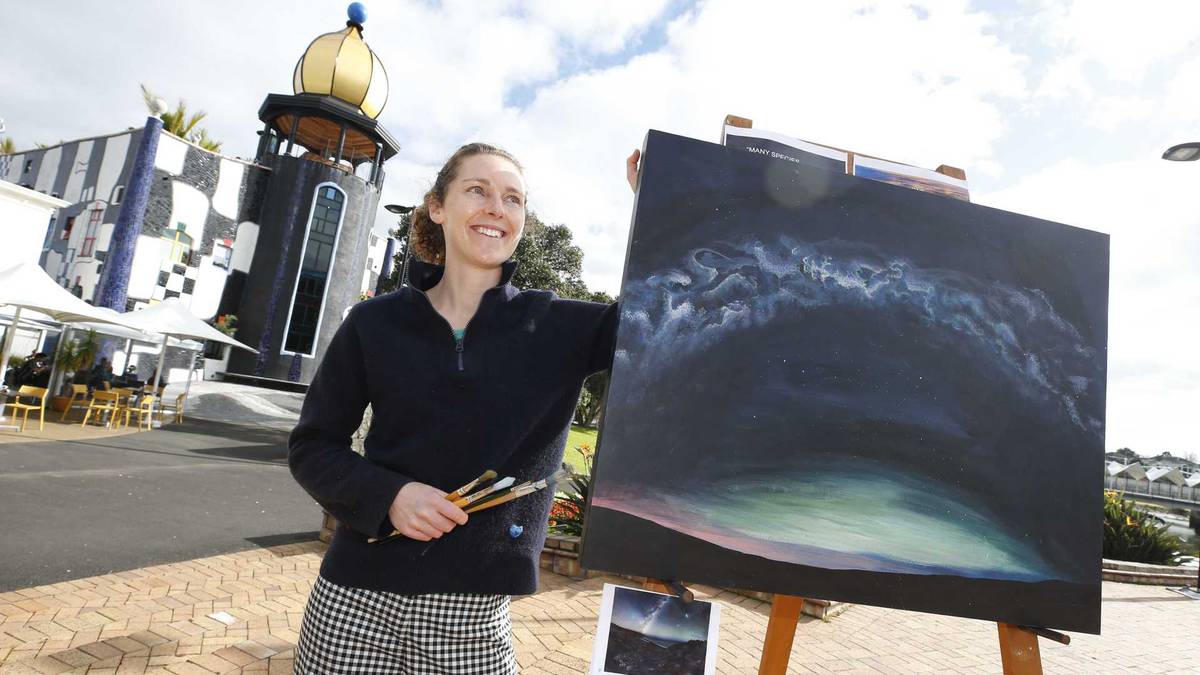Kerikeri’s Anna Clarke is using interactive art to call for protection of Northland’s night skies, possibly through the creation of a dark sky reserve. Photo / Michael Cunningham
A Kerikeri woman is using art to raise awareness of the need to preserve Northland’s starry skies.
Anna Clarke has been taking her easel to a different location each day as she works on a
painting of the Milky Way arching across the night sky.
As people stop to see what she’s doing she talks with them and encourages them to sign an open letter to the Far North District Council, calling on the organisation to investigate setting up a dark sky sanctuary and do what it can to limit light pollution.
So far she has set up her easel outside Rock Salt Bar and the Farmers’ Market in Kerikeri, and the Hundertwasser Art Centre in Whangārei.
The interactive painting was a vehicle for raising awareness, Clarke said.
At some point, if she didn’t reach her target number of signatures, she would slowly start destroying her artwork by painting streetlights over it.
People who couldn’t catch up with her in person could follow her progress via her Facebook or Instagram pages, called Anna Clarke Wearable Art.
Clarke said she’d noticed the nights getting steadily lighter as Kerikeri and Waipapa became more urbanised.
Matariki, with its focus on the stars, seemed a good time to start her campaign.
The response so far had been overwhelmingly positive, she said.
“I think it’s something we should value having here in Northland. Eighty per cent of people in the world can’t see the Milky Way due to light pollution so we’re extremely lucky. We could make it part of our identity and aim to be the first entire region to become a dark sky reserve.”
Clarke said preserving night skies went beyond just seeing the stars.
A loss of night-time darkness had been found to affect human health by, among other things, interfering with sleep and circadian rhythms. It also affected plants and animals.
“Plus, it’s quite a spiritual thing to look at the stars and gain a perspective on your place in the universe. You realise that whatever you’re going through it’s just a tiny speck in the cosmos.”
Around the world 15 dark sky sanctuaries and 20 dark sky reserves have been recognised by the International Dark-Sky Association.
In New Zealand, sanctuaries cover Aotea/Great Barrier Island and Rakiura/Stewart Island. The only current reserve covers Aoraki/Mt Cook National Park and the Mackenzie Basin.
In 2019 the ecotourism benefits of dark sky status prompted council community development advisor Ken Ross to investigate establishing a North Hokianga dark sky reserve.
The idea was backed by Kohukohu and Broadwood residents, but wider support had to be demonstrated before it could be progressed further.
Dark sky status entails restrictions on some types of development through changes in the District Plan limiting future light pollution.
Clarke studied art at Kerikeri High School before completing a science degree. More recently the 26-year-old worked for Southland’s regional development agency and as a water taxi driver on Stewart Island, which piqued her interest in dark sky preservation.




